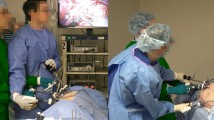Abstract
Background
To overcome the field of view and ergonomic limitations of standard laparoscopes, we are developing a multi-resolution foveated laparoscope that can simultaneously obtain both wide- and zoomed-in-view images through a single scope. To facilitate the effective access to the dual views of images with different resolution and field coverage acquired by our laparoscope, six different display modes have been developed. Each of the six display modes has inherent advantages and disadvantages. This study compares the six display modes through a human-subject experiment, which was conducted with an emulated laparoscope using a 4K camera.
Methods
Twenty-four subjects without medicine background performed three evaluation trials of a touching task with each of the display modes. Various objective measurements including task completion time, the number of collisions, gaze position, and tooltip position, and subjective preference for the display modes were recorded.
Results
For all the measurements except for task completion time and moving speed of tooltip, there were statistically significant differences among the display modes. Although the focus plus warped context view mode was selected as one of the least preferred modes, it showed the best task performance.
Conclusions
The unblocked wide context view was useful to provide a situational awareness even when it was severely distorted in some of the display modes, and information continuity played an important role in improving task performance. Moreover, the position change of viewing window coupled to the location of region of interest helped improve task performance, by providing an additional cue for spatial awareness.






Similar content being viewed by others
References
Cuschieri A (1991) Minimal access surgery and the future of interventional laparoscopy. Am J Surg 161:404–407
Heemskerk J, Zandbergen R, Maessen JG, Greve JWM, Bouvy ND (2006) Advantages of advanced laparoscopic systems. Surg Endosc 20:730–733
Parker WH (2010) Understanding errors during laparoscopic surgery. Obstet Gynecol Clin N Am 37(3):437–449
Pierre SA, Ferrandino MN, Simmons WN, Fernandez C, Zhong P, Albala DM, Preminger GM (2009) High definition laparoscopy: objective assessment of performance characteristics and comparison with standard laparoscopy. J Endourol Soc 23:523–528
Kim SP, Shah ND, Weight CJ, Thompson RH, Moriarty JP, Shippee ND, Costello BA, Boorjian SA, Leibovich BC (2011) Contemporary trends in nephrectomy for renal cell carcinoma in the United States: results from a population based cohort. J Urol 186(5):1779–1785
Bernie JE, Venkatesh R, Brown J, Gardner TA, Sundaram CP (2005) Comparison of laparoscopic pyeloplasty with and without robotic assistance. JSLS-J Soc Laparoendosc Surg 9:258–261
Tsai FS, Johnson D, Francis CS, Cho SH, Qiao W, Arianpour A, Mintz Y, Horgan S, Talamini M, Lo Y-H (2010) Fluidic lens laparoscopic zoom camera for minimally invasive surgery. J Biomed Opt 15(3):030504
Goel R, Lomanto D (2012) Controversies in single-port laparoscopic surgery. Surg Laparosc Endosc Percutan Tech 22(5):380–382
Canes D, Desai MM, Aron M, Haber G-P, Goel R, Stein J, Kaouk JH, Gill IS (2008) Transumbilical single-port surgery: evolution and current status. Eur Urol 54:1020–1029
Qin Y, Hua H, Nguyen M (2013) Development of a laparoscope with multi-resolution foveation capability for minimally invasive surgery. Proceedings of SPIE 8573, design and quality for biomedical technologies VI, 857309, February 2–3 2013, San Francisco, CA
Cockburn A, Karlson A, Bederson BB (2009) A review of overview + detail, zooming, and focus + context interfaces. ACM Comput Surv 41(1):2:1–2:31
Oh J-Y, Hua H (2008) Usability of multi-scale interfaces for 3D workbench displays. Presence 17(5):415–440
Jiang X, Zheng B, Atkins MS (2015) Video processing to locate the tooltip position in surgical eye-hand coordination tasks. Surg Innov 22(3):285–293
Liu F, Gleicher M (2005) Automatic image retargeting with fisheye-view warping. Proc 18th Annu ACM symp user interface softw technol (UIST 05), October 23–27 2005, Seattle, WA, pp. 153–162
Cao A, Ellis RD, Klein ED, Auner GW, Klein MD, Pandya AK (2008) Comparison of a supplemental wide field of view versus a single field of view with zoom on performance in minimally invasive surgery. Surg Endosc 22:1445–1451
Shah RD, Cao A, Golenberg L, Ellis RD, Auner GW, Pandya AK, Klein MD (2009) Performance of basic manipulation and intracorporeal suturing tasks in a robotic surgical system: single- versus dual-monitor views. Surg Endosc 23:727–733
Hornbæk K, Frøkjær E (2003) Reading patterns and usability in visualizations of electronic documents. ACM Trans Comput-Hum Interact 10(2):119–149
Gutwin C, Skopik A (2003) Fisheye views are good for large steering tasks. Proc ACM SIGCHI Conf human factors in computing systems (CHI’03), April 05–10 2003, Ft. Lauderdale, FL, pp. 201–208
Liu C, Chapuis O, Beaudouin-Lafon M, Lecolinet E, Mackay W (2014) Effects of display size and navigation type on a classification task. Proc ACM SIGCHI Conf human factors in computing systems (CHI’14), April 26-May 01 2014, Toronto, ON, pp. 4147–4156
Butscher S, Reiterer H (2016) Applying guidelines for the design of distortions on focus + context interfaces. Proc Int Working Conf advanced visual interfaces (AVI’16), June 07–10 2016, Bari, pp. 244–247
Acknowledgements
This work was supported by National Institutes of Health (NIH) Grant Award 1R01EB18921-01.
Author information
Authors and Affiliations
Corresponding authors
Ethics declarations
Disclosures
Dr. Hong Hua has a patent Multi-Resolution Foveated Endoscope/Laparoscope (pending) and a patent Optical Article and Illumination System for Endoscope (pending), and has no other related conflicts of interest or financial ties to disclose. Drs. Sangyoon Lee, Mike Nguyen, and Allan J. Hamilton have no conflicts of interest or financial ties to disclose.
Rights and permissions
About this article
Cite this article
Lee, S., Hua, H., Nguyen, M. et al. Comparison of six display modes for a multi-resolution foveated laparoscope. Surg Endosc 33, 341–351 (2019). https://doi.org/10.1007/s00464-018-6445-0
Received:
Accepted:
Published:
Issue Date:
DOI: https://doi.org/10.1007/s00464-018-6445-0




